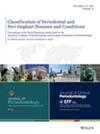Transcriptome analysis of granulation tissue from periodontal osseous defects.
IF 3.8
2区 医学
Q1 DENTISTRY, ORAL SURGERY & MEDICINE
引用次数: 0
Abstract
BACKGROUND Granulation tissue is routinely discarded in periodontal surgical procedures, but few studies have characterized it. The present study aimed to compare global gene expression in granulation tissue derived from different types of periodontal osseous defects. METHODS Total RNA was isolated from granulation tissue harvested during routine periodontal surgical procedures. Nineteen sites were analyzed-seven infrabony, six suprabony, and six furcation defects. Following quality control checks, samples underwent bulk mRNA sequencing (20-30 million read pairs per sample) before bioinformatic analyses utilizing gene ontology and associated pathway/enrichment analyses. RESULTS No statistically significant differentially expressed genes (DEG) were detected between different osseous defect types. An increase in the expression of 11 genes with a false discovery rate of <0.05 was detected when a comparison was made in terms of healing duration post nonsurgical periodontal therapy (NSPT). Notably, the genes involved included those regulating collagen synthesis and osteogenic activity. Analysis based on sex differences revealed 38 DEG. Gene enrichment analysis revealed that 24 DEG without Y-linked attachment are mostly involved in immune regulation. CONCLUSIONS Routinely discarded periodontal granulation tissue exhibits epithelial characteristics due to a substantial period of maturation post NSPT. Confirmation of ongoing maturation beyond traditional periodontal re-evaluation timepoints warrants further investigation on tissue differentiation potential. More research is needed to elucidate the role of sex as a biological variable affecting periodontal immune response. PLAIN LANGUAGE SUMMARY Granulation (wound) tissue is routinely removed during gum (periodontal) surgical procedures, but knowledge on its characteristics is scarce. This study aimed to compare gene expression in granulation tissue derived from different types of periodontal bone defects via high-throughput RNA sequencing. Total RNA was extracted from 95 samples harvested from gum disease patients during surgery. After quality control checks, 19 samples (seven infrabony, six suprabony, and six furcation defects) were eligible for sequencing. Subsequent analyses were done utilizing software with known cell biological pathways and processes. Analysis revealed no differentially expressed genes (DEG) in terms of periodontal defect category. There was statistically significantly increased expression of 11 genes when a comparison was made in terms of healing duration following deep scaling treatment. These genes are involved in collagen synthesis and osteogenic activity. Interestingly, analysis based on sex differences detected 38 DEG. Gene enrichment analysis revealed that 24 DEG without association with Y chromosomes are mostly involved in the regulation of immune system response. Routinely discarded periodontal granulation tissue exhibits lining cell characteristics that change over time following deep scaling treatment. More research is needed to unravel the role of sex as a biological variable affecting periodontal immune response in this type of tissue.牙周骨缺损肉芽组织转录组分析。
背景:在牙周外科手术过程中,肉芽组织通常被丢弃,但很少有研究对其进行描述。本研究旨在比较来自不同类型牙周骨缺损的肉芽组织中的全局基因表达。方法从常规牙周外科手术收获的肉芽组织中分离总RNA。共分析了19个位点,包括7个次键、6个上键和6个官能缺陷。在质量控制检查之后,样品进行了大量mRNA测序(每个样品2000 - 3000万对读对),然后利用基因本体和相关途径/富集分析进行生物信息学分析。结果不同骨缺损类型间DEG基因表达差异无统计学意义。当比较非手术牙周治疗(NSPT)后的愈合时间时,发现11个错误发现率<0.05的基因表达增加。值得注意的是,涉及的基因包括那些调节胶原合成和成骨活性的基因。基于性别差异的分析显示38个DEG,基因富集分析显示24个DEG无Y-linked attachment主要参与免疫调节。结论:常规丢弃的牙周肉芽组织由于NSPT后相当长的成熟期而表现出上皮性特征。确认正在进行的成熟超过传统的牙周再评估时间点,需要进一步调查组织分化潜力。需要更多的研究来阐明性别作为影响牙周免疫反应的生物学变量的作用。肉芽(伤口)组织通常在牙龈(牙周)手术过程中被移除,但对其特征的了解很少。本研究旨在通过高通量RNA测序来比较不同类型牙周骨缺损肉芽组织中的基因表达。从手术期间牙龈疾病患者收集的95个样本中提取总RNA。经质控检查,19份样品(7份次键、6份上键、6份分叉缺陷)符合测序条件。随后的分析利用已知的细胞生物学途径和过程的软件完成。分析显示,在牙周缺陷类别方面没有差异表达基因(DEG)。比较深度刮皮治疗后的愈合时间,11个基因的表达有统计学意义上的显著增加。这些基因参与胶原合成和成骨活性。有趣的是,基于性别差异的分析检测到38 DEG。基因富集分析显示,与Y染色体无关的24 DEG主要参与免疫系统反应的调节。常规丢弃的牙周肉芽组织表现出随时间推移而改变的内层细胞特征。需要更多的研究来揭示性别作为影响这类组织中牙周免疫反应的生物学变量的作用。
本文章由计算机程序翻译,如有差异,请以英文原文为准。
求助全文
约1分钟内获得全文
求助全文
来源期刊

Journal of periodontology
医学-牙科与口腔外科
CiteScore
9.10
自引率
7.00%
发文量
290
审稿时长
3-8 weeks
期刊介绍:
The Journal of Periodontology publishes articles relevant to the science and practice of periodontics and related areas.
 求助内容:
求助内容: 应助结果提醒方式:
应助结果提醒方式:


